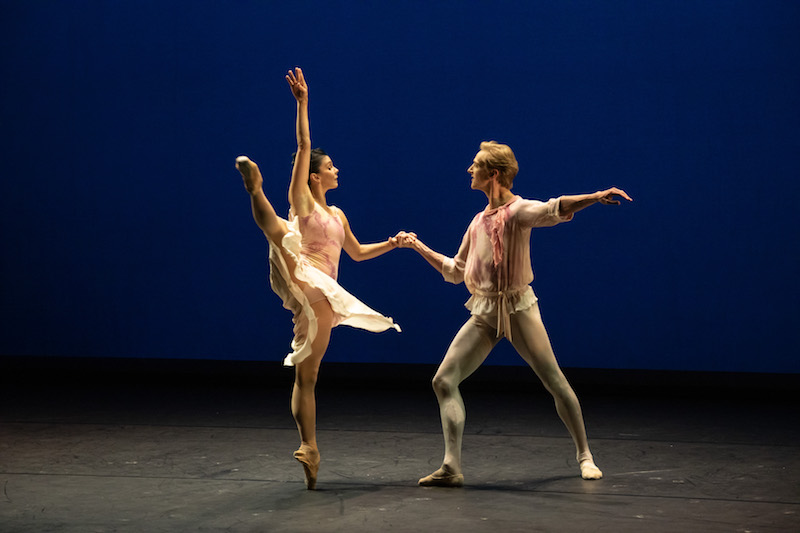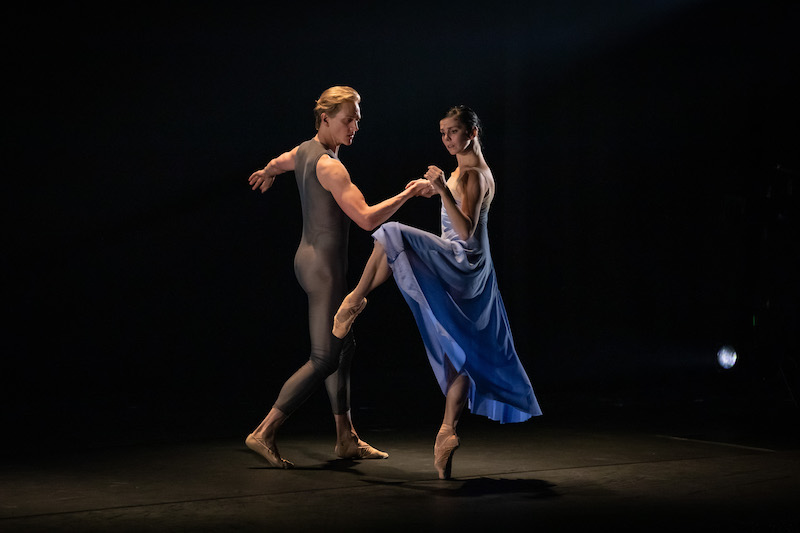It is hard to imagine a more perfect dance partnership than that between Natalia Osipova and David Hallberg. That perfection was made very clear in the opening moments of Pure Dance, a program of six short works curated by Osipova. She and Hallberg began the evening with the main pas de deux from The Leaves are Fading, a masterwork from Antony Tudor, first performed in 1975. With its intricate and demanding choreography, this pas de deux requires beautiful fluidity from the dancers and absolute trust between them, such is the nature of some of the spectacular partnering that is required. Osipova and Hallberg had it all. They were in total control technically and able to project such joy, and such pleasure in being together.
 Natalia Osipova and David Hallberg in The Leaves are Fading. Photograph © Daniel Boud
Natalia Osipova and David Hallberg in The Leaves are Fading. Photograph © Daniel Boud
From Osipova we saw incredibly liquid arm movements, beautiful use of the upper body, and an ability to make every movement look so easy. There was almost a nonchalance in the way she executed the choreography. From Hallberg came breathtaking turns, and pure classical line throughout his whole body. It was inspirational dancing.
The two works that followed did not have quite the same attraction. Flutter, a duet for Osipova and guest artist Jonathan Goddard with choreography by Iván Pérez, seemed not to have a strong, clear structure as it rushed hither and thither around the stage. I thought In Absentia, a solo for Hallberg choreographed by Kim Brandstrup, also lacked a coherent use of space, although it seemed more introspective and hardly moved anywhere by comparison with Flutter. But the dancerly qualities that Osipova and Hallberg demonstrated in Leaves were still there, and very obviously so – especially Osipova’s incredibly fast footwork in Flutter.
The second half of the evening contained some exciting new choreography and standout performances. Roy Assaf’s Six Years Later was a brilliant, danced conversation between Osipova and guest artist Jason Kittelberger. What was the relationship between them? Sometimes it seemed aggressive, sometimes filled with regular engagement, sometimes quite loving. And all those feelings were expressed through movement that was filled with complex interactions and some beautifully shaped, quite unusual choreography. There were moments when arms and hands told the story, others when it was the feet, others when it was bodies locked together.
The penultimate piece, Ave Maria, a solo for Osipova choreographed by emerging Japanese artist Yuka Oishi, was exceptional. Oishi says in her program notes that her work was not meant to be a religious piece despite the music (Ave Maria by Franz Schubert). Yet it is impossible to hear an Ave Maria without particular thoughts being in one’s mind. Oishi’s choreography was filled with movement that seemed, appropriately I thought, to encapsulate something quite universal. There was some more exceptional dancing from Osipova in this work. She brought out the choreographic contrasts with which Oishi had imbued her Ave Maria. The movement ranged from expansive jumps to moments when Osipova seemed to tremble as her hands shook and her body lent forward.
 David Hallberg and Natalia Osipova in Valse Triste. Photograph © Daniel Boud
David Hallberg and Natalia Osipova in Valse Triste. Photograph © Daniel Boud
The evening closed with Valse Triste, a short pas de deux for Osipova and Hallberg choreographed for them by Alexei Ratamansky to dramatic and moving music by Jean Sibelius. Once again we saw that amazing partnership at work – two bodies working as one, showing Ratmansky’s signature style where movements weave together seamlessly and where gorgeous unison happens unexpectedly. Again Osipova and Hallberg had it all.
What a night it was. And what a pleasure it was to see such diverse choreography across the evening, and to see two exceptional dancers, and their two guests, dancing with such presence and passion for their chosen art form.
Pure Dance plays at the Drama Theatre, Sydney Opera House, until August 31











Comments
Log in to join the conversation.